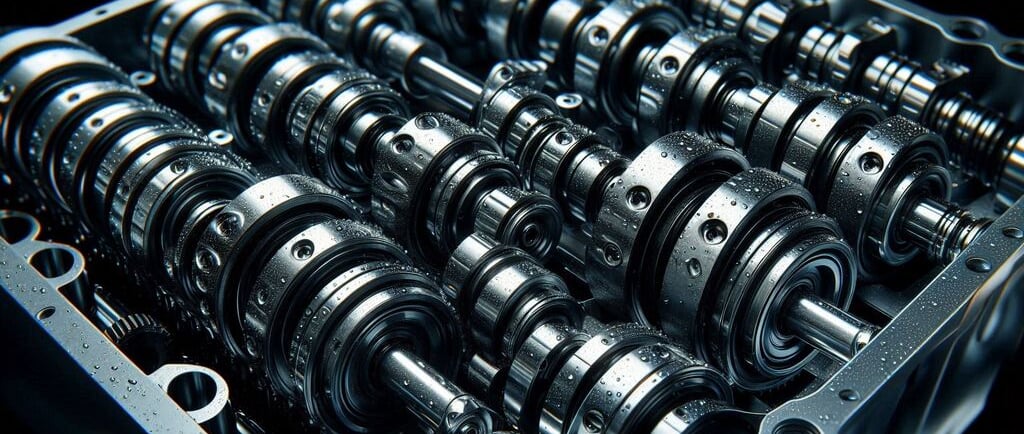Crankshafts and Camshafts
In the world of car engines, there are a few key components that power the entire system. Among them, crankshafts and camshafts are two of the most critical.
ENGINE COMPONENTS
11/13/20244 min read


Crankshafts and Camshafts: Essential Engine Components Explained
In the world of car engines, there are a few key components that power the entire system. Among them, crankshafts and camshafts are two of the most critical. These parts work together to keep your engine running smoothly, but they serve very different functions. Whether you’re a car enthusiast or just looking to understand more about how your vehicle operates, knowing the difference between crankshafts and camshafts can give you deeper insight into engine mechanics. Let’s dive in!
What is a Crankshaft?
The crankshaft is often referred to as the "heart" of the engine because it converts the linear motion of the pistons into the rotational motion needed to drive the wheels. In simpler terms, it’s the part of the engine that helps generate power and keeps the wheels moving.
How the Crankshaft Works
In an internal combustion engine, fuel combustion creates explosions that push the pistons up and down. This motion is transferred to the crankshaft, which spins and provides the necessary torque to the wheels. The crankshaft is connected to each piston by connecting rods, which help in converting the up-and-down motion into rotational energy.
Key Functions of the Crankshaft:
Converts Linear to Rotational Motion: The crankshaft takes the vertical motion of the pistons and converts it to rotational motion to drive the vehicle.
Supports Engine Timing: The crankshaft also plays a critical role in engine timing, ensuring that all parts work together in sync.
What is a Camshaft?
While the crankshaft handles motion, the camshaft takes on the responsibility of controlling air intake and exhaust. It does this by opening and closing the engine’s valves in a precise sequence, which allows the fuel-air mixture to enter the combustion chamber and the exhaust gases to exit.
How the Camshaft Works
The camshaft is positioned at the top of the engine and is driven by the crankshaft through a belt or chain. As the camshaft rotates, its lobes push against the valve stems, causing the valves to open and close. Proper timing here is crucial, as the intake and exhaust processes must be precisely aligned with the piston’s movements.
Key Functions of the Camshaft:
Regulates Air and Fuel Flow: By opening and closing the valves, the camshaft controls the flow of air and fuel into the combustion chamber.
Assists with Exhaust: It also ensures that exhaust gases are expelled at the right moment, maintaining a clean and efficient engine.
Differences Between Crankshafts and Camshafts
Though they work in unison, crankshafts and camshafts are very different in terms of function and operation. Here’s a quick breakdown:
FeatureCrankshaftCamshaftFunctionConverts piston motion to rotational motionOpens and closes engine valvesLocationBottom of the engine blockNear the top of the engineTimingRotates with the pistonsRotates at half the speed of the crankshaftMaterialTypically made from forged steel or cast ironOften made from cast iron or billet steel
Understanding these differences is essential for anyone looking to grasp the basics of engine mechanics. Essentially, while the crankshaft provides the power to move the vehicle, the camshaft controls the airflow needed for combustion.
How Crankshafts and Camshafts Work Together
The synchronization between the crankshaft and camshaft is crucial for the engine to operate efficiently. If the timing is off even slightly, it can lead to poor performance or even significant engine damage. This timing is managed by a timing belt or timing chain, which connects the two shafts and ensures they rotate in sync.
Timing Belt or Chain
The timing belt or chain keeps the crankshaft and camshaft rotating in a precise sequence. This allows for optimal fuel combustion, providing smooth and efficient power delivery. Regular maintenance of this timing component is essential, as a broken timing belt or chain can lead to a total engine failure.
Benefits of Synchronization
Improved Fuel Efficiency: When the camshaft and crankshaft are in sync, fuel combustion is more efficient, which helps improve fuel economy.
Reduced Emissions: Proper timing also reduces the release of unburned fuel, which can lower emissions.
Enhanced Performance: A well-timed engine will run smoothly, ensuring the vehicle performs at its best.
Common Issues with Crankshafts and Camshafts
Despite their importance, both the crankshaft and camshaft can encounter problems that impact engine performance. Let’s look at a few common issues:
Crankshaft Problems
Wear and Tear: Over time, the crankshaft can wear down, especially the bearing surfaces.
Crankshaft Position Sensor Failure: The position sensor monitors the crankshaft’s speed and position, and a failure can lead to engine misfires or stalling.
Camshaft Problems
Camshaft Wear: Since the camshaft is continuously pressing against the valve lifters, it can wear down over time, causing issues with valve operation.
Camshaft Position Sensor Failure: Similar to the crankshaft sensor, a faulty camshaft sensor can lead to poor engine performance and reduced fuel efficiency.
Maintenance Tips
To keep your engine’s crankshaft and camshaft in good shape, consider the following:
Regular Oil Changes: Good oil quality reduces friction and wear on engine components.
Inspect Timing Belt or Chain: Regularly check your timing belt or chain for wear, as this is vital for keeping the camshaft and crankshaft synchronized.
Replace Worn Sensors: Replacing crankshaft and camshaft position sensors can help maintain smooth engine performance.
Conclusion: The Vital Role of Crankshafts and Camshafts in Your Engine
Crankshafts and camshafts might seem like complex parts, but they serve fundamental roles in engine operation. By understanding how these parts work together to keep your engine running smoothly, you can better appreciate the engineering that powers your vehicle. Regular maintenance, such as checking your timing belt, inspecting sensors, and changing the oil, can extend the life of these components and keep your engine performing at its best.



